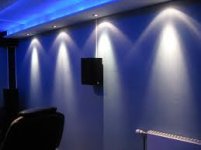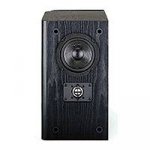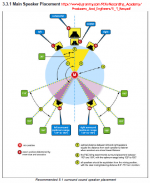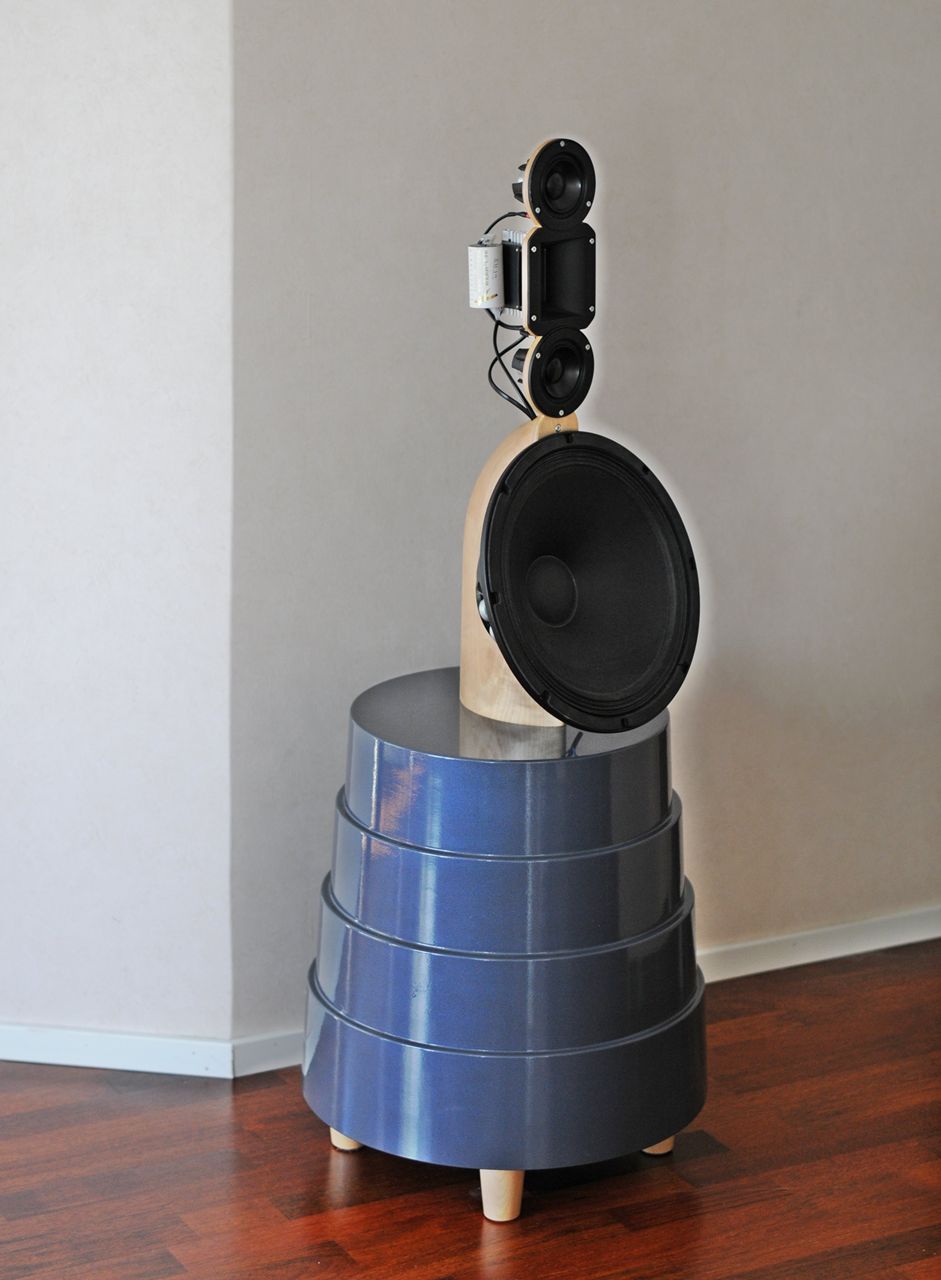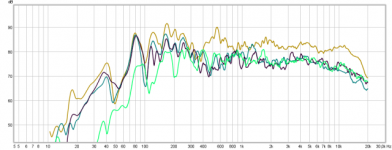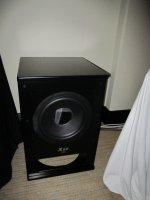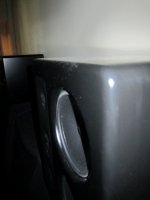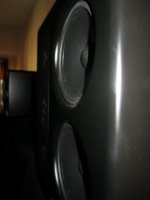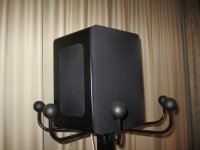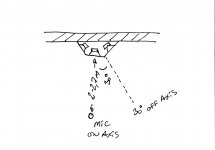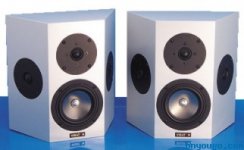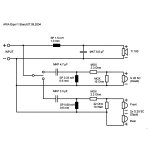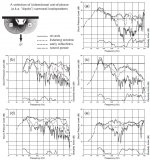I'm the happy owner of a complete JBL HT1 speaker set. I use the HT1F as rear in a 7.1 setup, and the HT1D as sides. I use my own center and front speakers, and I have built the subs into other boxes.
The interest here is the dipole HT1D speakers. They are placed on the sides directly out from the listening position.
It imploys a vented design and goes to 110 Hz according to JBL.
Though I think they work well, there is always a thought of upgrading
Have searched the net for diy constructions of a dipole surround speaker, without much luck.
Not really sure about the requirements either. How low frequency is it going to see? ..... of course cant find any good information on THX requirements ...... seem the proffesional speakers for cinema use go down to btw. 40 and 60 Hz .....
As a dipole, if nothing special is done, then it will fall rapidly at something like F = 0.17*c/D, where c = 343 m/s and D is the distance btw the opposite speaker units (in meters) (according to Linkwitzlab.
As mine go down to 110 and uses a port something must done in the crossover ot handle this .... not sure how.
Some uses an extra single bass .... guess below the dipole frequency mentioned abowe ..... some (e.g. Jamo) uses also long cabinets to increase D and thereby lower ths frequency.
Any of you have any experience with such designs?
Does anyone have some links / articles / other information on the subject ..... or schematic on crossover design etc.
Could be really fun to build something which really works, and which sounds better than my old speakers without costing a fortune .... anyone game??
Regards Baldin
The interest here is the dipole HT1D speakers. They are placed on the sides directly out from the listening position.
It imploys a vented design and goes to 110 Hz according to JBL.
Though I think they work well, there is always a thought of upgrading
Have searched the net for diy constructions of a dipole surround speaker, without much luck.
Not really sure about the requirements either. How low frequency is it going to see? ..... of course cant find any good information on THX requirements ...... seem the proffesional speakers for cinema use go down to btw. 40 and 60 Hz .....
As a dipole, if nothing special is done, then it will fall rapidly at something like F = 0.17*c/D, where c = 343 m/s and D is the distance btw the opposite speaker units (in meters) (according to Linkwitzlab.
As mine go down to 110 and uses a port something must done in the crossover ot handle this .... not sure how.
Some uses an extra single bass .... guess below the dipole frequency mentioned abowe ..... some (e.g. Jamo) uses also long cabinets to increase D and thereby lower ths frequency.
Any of you have any experience with such designs?
Does anyone have some links / articles / other information on the subject ..... or schematic on crossover design etc.
Could be really fun to build something which really works, and which sounds better than my old speakers without costing a fortune .... anyone game??
Regards Baldin
Attachments
Hi,
You won't find decent dipole designs because the design
process reveals how seriously flawed they really are.
rgds, sreten.
You won't find decent dipole designs because the design
process reveals how seriously flawed they really are.
Zaph
Any chance of designing bipole and/or dipole surrounds?
No chance of that, and I recommend a ZA5.2 monopole for surrounds. The reason is that typical bipole and dipole surround speakers are seriously flawed designs, and the issues can be very audible in most installations. With dipole, generally 2 woofers and 2 tweeters are mounted in an angled cabinet and wired out of phase. If you sit exactly on axis, it's a full null in response and all you get is a reverberant sound field comprised of the systems's flawed power response. Interesting and sometimes freaky spacious sounding, but not at all realistic. Going off axis, even slightly, will result in a seriously combfiltered frequency response. Bipole surrounds have similar issues except that they will only sound normal on axis. Off axis, comb filtering shows up fast, particularly if the design has two tweeters. A final bit of information is that most mixing and mastering studios use monopole surrounds because studio designers are also well aware of the problems of bipole and dipole designs. The commercial hifi market is loaded with bipole and dipole surrounds because people keep buying them.
rgds, sreten.
I think it's about compromises .....
A monopole speaker as surround in a small room will I think, always be "detectable" and "pointy" .... In a large cinema this is not a problem as you achieve far field ...
To say it's simply no good I think is just a bit too fast .....
Still required by THX .... and you can of course always just say that they dont know what they are doing ..... which would also be a bit too fast I thing ....
What dipoles do you have experience with?
I think in my room, no matter how I would place the surround speakers, they would always be too close and to dominant ....
So how could we design a dipole with better power responce??
best regards Baldin
A monopole speaker as surround in a small room will I think, always be "detectable" and "pointy" .... In a large cinema this is not a problem as you achieve far field ...
To say it's simply no good I think is just a bit too fast .....
Still required by THX .... and you can of course always just say that they dont know what they are doing ..... which would also be a bit too fast I thing ....
What dipoles do you have experience with?
I think in my room, no matter how I would place the surround speakers, they would always be too close and to dominant ....
So how could we design a dipole with better power responce??
best regards Baldin
I have never understood why anyone wants to make "dipole" or bipole surround speakers! The Dolby Surround or THX or any concept use only monopole speakers. Mixing studios use monopoles. Multichannel preamplifiers have a setup scheme where speaker distances (delays) and levels are set.
Surround sound - Wikipedia, the free encyclopedia
Surround Sound Mixing
http://www2.grammy.com/PDFs/Recording_Academy/Producers_And_Engineers/5_1_Rec.pdf
This is from the Grammy paper
Surround sound - Wikipedia, the free encyclopedia
Surround Sound Mixing
http://www2.grammy.com/PDFs/Recording_Academy/Producers_And_Engineers/5_1_Rec.pdf
This is from the Grammy paper
Only direct radiator speakers should be used for music surround sound mixing.
Because of their dependence upon reflective surfaces and the phase anomalies
inherent in their design, dipole speakers will produce inaccurate results when
placed in an acoustically tuned professional mixing environment. However, it
may be helpful to check a surround mix on a consumer system equipped with
dipole speakers, provided the system is physically located in a room that
simulates a typical home theater listening environment. (See section 2.3)Because of their dependence upon reflective surfaces and the phase anomalies
inherent in their design, dipole speakers will produce inaccurate results when
placed in an acoustically tuned professional mixing environment. However, it
may be helpful to check a surround mix on a consumer system equipped with
dipole speakers, provided the system is physically located in a room that
Attachments
Last edited:
By the way a quite poplar solution for surround speakers is to use omnipole speakers! The problem is always treble - how to get wide dispersion without cancellations/lobing. Some kind of diffusor is used by Mirage, Duevel and Visaton Fontana
Mirage : Omnisat Series : OS³-Sat
Duevel high-end loudspeakers
FONTANA
Pluto introduction
Mirage : Omnisat Series : OS³-Sat
Duevel high-end loudspeakers
FONTANA
Pluto introduction
An externally hosted image should be here but it was not working when we last tested it.
An externally hosted image should be here but it was not working when we last tested it.
Hi Juhazi and sreten
My goal was definitely not to try to convince anyone that dipoles are better or the only way to go. If I had a larger room (or only one seat), I’m sure I would be better off with direct radiating speakers. Actually I’ll try in the near future to shift from my side speakers to the HT1F speakers I have in the back (used for 6.1 and 7.1), to see whether they sound better.
I also like the idea of using omnipolar speakers or maybe something like the lenses B&O is using.
What is best I think highly depend on the room. Mine is small, narrow (long) and well dampened, and direct radiating sound is quite easy to locate. It’s all about striking the right compromise.
Anyway, what I would like to hear is whether anyone have some experience building or constructing dipole surround speakers, or whether anyone have some material on some either diy or commercial? ……
Thanks in advance
Baldin
My goal was definitely not to try to convince anyone that dipoles are better or the only way to go. If I had a larger room (or only one seat), I’m sure I would be better off with direct radiating speakers. Actually I’ll try in the near future to shift from my side speakers to the HT1F speakers I have in the back (used for 6.1 and 7.1), to see whether they sound better.
I also like the idea of using omnipolar speakers or maybe something like the lenses B&O is using.
What is best I think highly depend on the room. Mine is small, narrow (long) and well dampened, and direct radiating sound is quite easy to locate. It’s all about striking the right compromise.
Anyway, what I would like to hear is whether anyone have some experience building or constructing dipole surround speakers, or whether anyone have some material on some either diy or commercial? ……
Thanks in advance
Baldin
Ok I understand your problems! Bipoles and dipoles are used to make a real mess of the sound coming from surround speakers. This mess of reflections is much stronger (in energy) than direct sound from these surround speakers - this is the trick. But then we loose the localization info (cues) "packed" in surround channels.
This will get really difficult because dipoles are really sensitive to positioning (the nulling at 90¤, but it is never perfect!) In real life their output at large angles is very different from on-axis. And respectively also power response is very much dependent on positioning, becaus most of "power" is reflections. You must do many many tests in your spesific room! It is easy to use our monopoles and just turn and push them around. Try also different heights! Remeber to play with delay settings too, also use non-ideal delays
This comes from my thinking ad rationalizing. I have two multichannels systems, for ten years and in three different rooms. All speakers are monopoles (Well dipoles as main LR in the other now). I am not happy at all about surrounds either but it is mainly because the rooms don't allow proper positioning. I have accepted that.
I believe that a "by book" home theaters are really rare!
Surround Sound Speaker Set Up THX.com
Home Theater Surround Sound Speaker Placement and Setup Guide
Home Theater Speaker Layout - An Essential Guide | Audioholics
This will get really difficult because dipoles are really sensitive to positioning (the nulling at 90¤, but it is never perfect!) In real life their output at large angles is very different from on-axis. And respectively also power response is very much dependent on positioning, becaus most of "power" is reflections. You must do many many tests in your spesific room! It is easy to use our monopoles and just turn and push them around. Try also different heights! Remeber to play with delay settings too, also use non-ideal delays
This comes from my thinking ad rationalizing. I have two multichannels systems, for ten years and in three different rooms. All speakers are monopoles (Well dipoles as main LR in the other now). I am not happy at all about surrounds either but it is mainly because the rooms don't allow proper positioning. I have accepted that.
I believe that a "by book" home theaters are really rare!
Surround Sound Speaker Set Up THX.com
Home Theater Surround Sound Speaker Placement and Setup Guide
Home Theater Speaker Layout - An Essential Guide | Audioholics
Last edited:
Oh - I just noticed that THX surrounds are supposed to be "dipole" unlike Dolby Surround and Dolby 5.1 or 7.1!
I have never before even looked at THX web page!
Now I understand why they are marketed! We know that THX and DD5.1 mixes are different, it must be because of the different type of surround SL SR speakers. THX says monopoles for rear speakers though.
Surround Speakers | Klipsch
Notice that Klipsh Palladium (top of the line) is breaking the rule with midbasses that are monopole! Other models look more like di - or bipoles but specifications don't tell how drivers are wired. There is a HUGE difference between those actually, in the way they work and sound.


I have never before even looked at THX web page!
Now I understand why they are marketed! We know that THX and DD5.1 mixes are different, it must be because of the different type of surround SL SR speakers. THX says monopoles for rear speakers though.
Surround Speakers | Klipsch
Notice that Klipsh Palladium (top of the line) is breaking the rule with midbasses that are monopole! Other models look more like di - or bipoles but specifications don't tell how drivers are wired. There is a HUGE difference between those actually, in the way they work and sound.


Last edited:
I recently designed a surround loudspeaker system configurable for wide - bipole - dipole configuration.
By using drivers with proper radiation pattern, proper placement and angling of the drivers, and proper crossover, it is possible to get reasonable performance in all those configurations.
However, it is not possible to avoid the inherent characteristics of the dipole design - the sound will be extremely dependent of listeners location, because on-axis there will always be a null, and there will be lobing. It sounds quite bad.
The bipole configuration is really only the normal wide with extended horisontal dispersion - 180 degrees full coverage. The sound is much better than the dipole config, and may be usable in some set-ups.
After measurements and testing I have never run them in dipole or bipole configuration. The normal wide sounds better with much better perceived location of sounds, and the speakers still disappears on reasonably good source material.
By using drivers with proper radiation pattern, proper placement and angling of the drivers, and proper crossover, it is possible to get reasonable performance in all those configurations.
However, it is not possible to avoid the inherent characteristics of the dipole design - the sound will be extremely dependent of listeners location, because on-axis there will always be a null, and there will be lobing. It sounds quite bad.
The bipole configuration is really only the normal wide with extended horisontal dispersion - 180 degrees full coverage. The sound is much better than the dipole config, and may be usable in some set-ups.
After measurements and testing I have never run them in dipole or bipole configuration. The normal wide sounds better with much better perceived location of sounds, and the speakers still disappears on reasonably good source material.
Oh - I just noticed that THX surrounds are supposed to be "dipole" unlike Dolby Surround and Dolby 5.1 or 7.1!
THX is a certification of equipment and installations to ensure that the sound will be as closely to what the film maker wanted to achieve. Dolby or DTS is the encoding system. ..... though both Dolby and DTS also have their own guide to setup .... yes confusing
Yes there is many ways to go. The Klipsh Palladium is not THX certified, but their KS-525-THX is.
Okv: do you have some pictures of your speakers? And would you share a bit more on the construction and how they measure?
Best regards Baldin
Okv: do you have some pictures of your speakers? And would you share a bit more on the construction and how they measure?
Best regards Baldin
Of course, but it will have to wait until the design is published, and I don't work that fast..
One complete surround speaker consist of two units, with drivers angled outwards, and the angle depends on the configuration.
Generally, they measure very linear on-axis from one unit, and not that bad in wide cfg with both units.
Off-axis is also quite nice, but boundary reflections when mounted on to a wall will always affect the response of such designs.
Compromises need to be made when the same units are configurable to three quite different radiation patterns, and I have focused on getting the more normal wide cfg to be the best, in bipole and dipole there will be so large contributions from room reflections anyway, so that it is really most important to get the power response reasonably right.
And usually the listening position will be lower than the speaker, so that you listen off-axis vertically as well, which means the hf will roll of some.
Found some fr plots, these are in-room at lp vertical 1m off ground, speakers mounted higher, 2.7m distance wide cfg (brown), 2m bipole (on-axis and 30 deg off horisontal, the other colours), 2m dipole (30 deg horisontal, green).
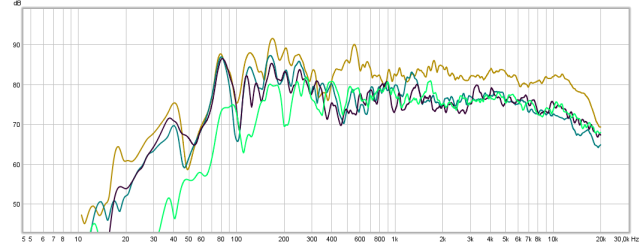
Attachments
Of course, but it will have to wait until the design is published, and I don't work that fast..
So it will be a commercial speaker ... not just DIY?
Looks really good.
Anyway just came back from the yearly HiFi and Sourround exhibition in Copenhagen. The show is getting smaller and smaller each year, and fewer end fewer people attend …. Belonging to a dying race!
Best / most impressive sound was a set-up with MK sound and Datasat. Processer was the professional RS20i, used in many large cinemas, and the power amp was the 7 x 300 W RA7300. Source was Oppo. … so the front end of business was up to spec
The speakers was a new series, which I can’t find on their web site (MK sound). Couldn´t get a good picture as the front speakers was placed behind the screen, but they told they are now equipped with Scan Speak units, and MK is now on Danish hands and produced in DK!!!
The surrounds was also new, but based on their Tripole principle.
As for bottom it was delivered by 3 x X12 (meaning in all six 12” speakers
The sound was simply stunning …… dynamics where through the roof, the sound simply just clear! ……… If I just had that kind of money
But back to the surrounds. The setup was 7.1 and all 4 surrounds was tripole. The sound was both diffuse, but with clear direction when panning the sound. But when playing the old THX trailer with the little guy repairing the back speakers, it was actually a little harder to follow him around than I have heard in the cinema! So I think, no matter what the concept is, monopole, dipole, tripole or something else … there will always be compromises. I didn’t have the possibility to hear any music on the system, so can’t say anything about that.
So how do they do this tripole thing??
Normal dipole on the sides, and I guess normal monopole on the front, but lowered some not to be too noticeable.
Wonder how a polarplot would look …. 3 distinct lopes, at least in the mid frequencies??
Anyone know more about these tripoles??
Baldin
PS. Would love to see more about your project Okv
Attachments
Last edited:
Hi OkvFound some fr plots, these are in-room at lp vertical 1m off ground, speakers mounted higher, 2.7m distance wide cfg (brown), 2m bipole (on-axis and 30 deg off horisontal, the other colours), 2m dipole (30 deg horisontal, green).

Just to understand the measurements corretly. do you measure 90 degrees out from the wall ... that is pointing to the front of the speaker? ... this is what you call on axis, right?
And the 30 degree off axis is 90 - 30 = 60 degree off wall.
You measure with the speaker mounted on the wall, and mounted higher the the 1m high listening position.
The curves are more similar than I would have thought. You didn't measure dipole on axis (where you would expect a null for at least some frequencies).
When you run in wide configurations, are all 3 speakers connected in phase then?
Are all 3 "sides" the same (1 way / 2 way)?
BR Baldin
Attachments
Last edited:
Very old but still interesting to some degree .... and measurements 
http://www.soundandvision.com/content/face-surround-speaker-configuration-wars
http://www.soundandvision.com/content/face-surround-speaker-configuration-wars
Interesting article .... not sure I agree with the conclusion, but it contains some interesting measurements:
Loudspeakers: Objective evaluations - Part 4: Measurements of real-world consumer loudspeakers | EE Times
Interesting is though to see that the power spectrum of different dipole designs looks quite ok ....
It is also clear to see that the 5 different speakers are of quite different desing ..... wonder which would sound best .... what pattern to go for ..... probably b or d ........
... not sure how listening window is defined ... sure this measurement angle sows a lot of combfiltering .... which would also be expected
Loudspeakers: Objective evaluations - Part 4: Measurements of real-world consumer loudspeakers | EE Times
Interesting is though to see that the power spectrum of different dipole designs looks quite ok ....
It is also clear to see that the 5 different speakers are of quite different desing ..... wonder which would sound best .... what pattern to go for ..... probably b or d ........
... not sure how listening window is defined ... sure this measurement angle sows a lot of combfiltering .... which would also be expected
Attachments
Last edited:
On the next page of that series Floyd Toole says that a CBT (horizontal?) is nearly perfect surround peaker
Loudspeakers: Objective evaluations - Part 4: Measurements of real-world consumer loudspeakers | EE Times
Loudspeakers: Objective evaluations - Part 4: Measurements of real-world consumer loudspeakers | EE Times
Hi Okv
Just to understand the measurements corretly. do you measure 90 degrees out from the wall ... that is pointing to the front of the speaker? ... this is what you call on axis, right?
And the 30 degree off axis is 90 - 30 = 60 degree off wall.
You measure with the speaker mounted on the wall, and mounted higher the the 1m high listening position.
The curves are more similar than I would have thought. You didn't measure dipole on axis (where you would expect a null for at least some frequencies).
When you run in wide configurations, are all 3 speakers connected in phase then?
Are all 3 "sides" the same (1 way / 2 way)?
BR Baldin
On-axis means 90deg off the wall, yes.
30 degrees off then means 30deg from on-axis, or 60deg from the wall surface.
The dipole measurement on-axis, in the null, will still show a frequency response not very different, due to room contribution - the measured response will be more like the power response.
Anechoic, or gated, measurement on-axis of the dipole shows the expected null - a very significant reduction.
These are full-range dipole, which means the bass level will be reduced in dipole mode, as the measurements show.
In all other modes (wide, bipole) all drivers are in phase, in dipole it acts like two similar speakers out of phase.
For a surround speaker, I am quite happy with the results for these speakers.
Computer simulations allowed for a significant reduction in development time, did the crossover adjustments in basically less than a week.
If this was to be an ordinary speaker intended for on-axis listening it would have a very flat on-axis frequency response.
The crossover is likely the most expensive part of the speaker, the drivers does not cost much.
If they will ever go into production I can not say now, even though the parts are not very high cost, they will be rather expensive surround speakers.
I will present the design, and then it will be easier to see how it is done, at least you can use it as an example and inspiration.
A surround speaker is not very critical - dimension for whatever SPL you need, build it, test, and if it performs well, good, if not, make some adjustments until it is good enough.
As you mention - it is easy to get the impression that the whole industry is dying, and if so, I blame the media industry - you have to go back to 80ies recordings to get good sounding music, and now they continue the destruction on movies, with low-frequency filtering, clipping and dynamic compression. No one needs a proper sound reproduction system to listen to flat and distorted noise.
- Status
- This old topic is closed. If you want to reopen this topic, contact a moderator using the "Report Post" button.
- Home
- Loudspeakers
- Multi-Way
- How to design a dipole surround speaker
